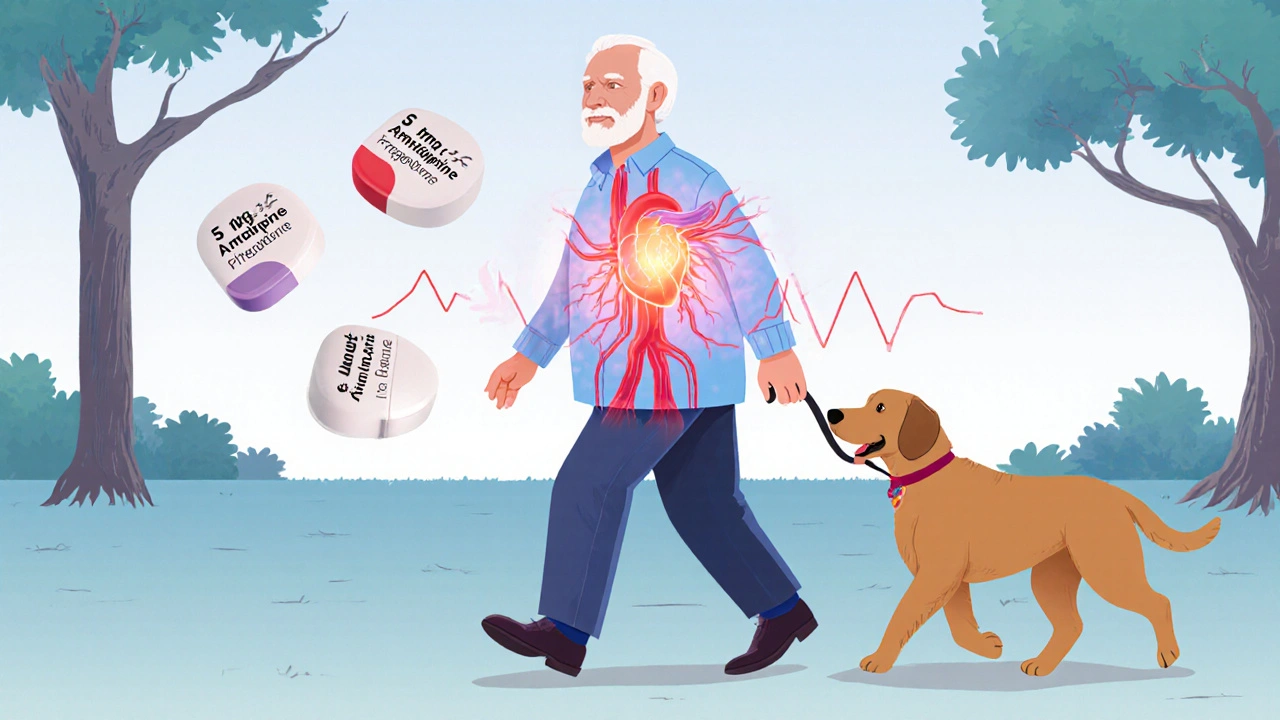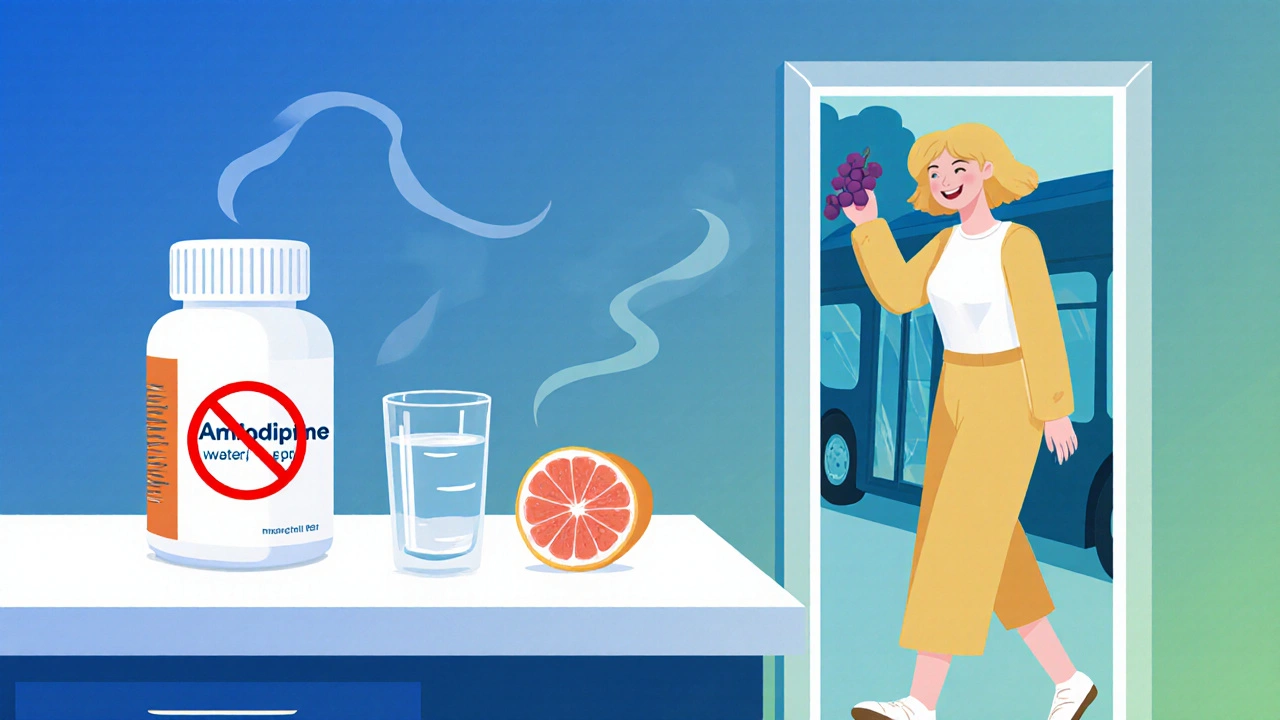When your chest feels tight, heavy, or like someone is squeezing it-especially when you’re walking, climbing stairs, or stressed-you’re not just having a bad day. You might be experiencing angina. And if your doctor has prescribed amlodipine, it’s not just a random pill. It’s one of the most trusted tools for managing this painful condition.
What Is Angina, Really?
Angina isn’t a heart attack. But it’s your heart’s way of screaming for help. It happens when your heart muscle doesn’t get enough oxygen-rich blood. This usually comes from narrowed or blocked arteries, often due to plaque buildup over time. The pain isn’t always sharp-it’s more like pressure, burning, or a dull ache. It might spread to your arm, neck, jaw, or back.
There are two main types: stable angina, which comes with predictable triggers like exercise or cold weather, and unstable angina, which can strike without warning and is more dangerous. Amlodipine is mainly used for stable angina. It doesn’t fix the blockages, but it helps your heart work less hard so it doesn’t need as much oxygen.
How Amlodipine Works
Amlodipine belongs to a class of drugs called calcium channel blockers. That sounds technical, but here’s what it means in plain terms: your heart and blood vessels need calcium to contract. Amlodipine gently blocks some of that calcium from entering the muscle cells in your arteries. This lets your blood vessels relax and widen-something doctors call vasodilation.
When your arteries open up, blood flows more easily. Your heart doesn’t have to pump as hard. That lowers your blood pressure and reduces the strain on your heart. Less strain means less oxygen demand-and less chest pain. It’s not a quick fix. You won’t feel relief the first time you take it. It takes about a week for levels to build up in your system. But once it does, it works steadily, 24 hours a day.
Why Doctors Choose Amlodipine Over Other Options
There are other medications for angina-like beta-blockers, nitrates, or ranolazine. So why amlodipine? For one, it’s long-lasting. You take it once a day. No need to time doses around meals or activities. It also doesn’t slow your heart rate like beta-blockers do, which makes it safer for people with slow heart rhythms or asthma.
Studies show that amlodipine reduces the frequency of angina attacks by about 40-60% in most people. In one large trial involving over 10,000 patients with stable angina, those on amlodipine had fewer hospital visits and better exercise tolerance after six months compared to those on placebo. It’s also effective when used with other heart meds, like statins or aspirin, which many angina patients take anyway.
Unlike nitrates-which can lose effectiveness over time-amlodipine doesn’t cause tolerance. You don’t need to increase the dose over months. And it’s gentle on the lungs, making it a go-to choice for older adults or those with COPD.
What to Expect When You Start Taking It
Most people tolerate amlodipine well. But side effects can happen, especially in the first few weeks. The most common ones include:
- Swelling in the ankles or feet (edema)
- Flushing or feeling warm
- Dizziness or lightheadedness
- Fatigue
- Headache
Swelling in the ankles is the most frequent complaint. It’s not dangerous, but it can be annoying. Elevating your feet, wearing compression socks, or reducing salt intake helps. If it gets bad, your doctor might lower your dose or add a diuretic.
Don’t stop taking it because of side effects. Talk to your doctor first. Suddenly stopping amlodipine can cause your blood pressure to spike or trigger rebound angina. That’s a real risk.
Some people worry about weight gain or liver damage. Amlodipine doesn’t cause either. It’s metabolized by the liver, but in healthy people, it rarely causes problems. If you have severe liver disease, your doctor may start you on a lower dose.

Dosing and How to Take It Right
The usual starting dose for angina is 5 mg once daily. Many people stay on that. Some need to go up to 10 mg if symptoms aren’t controlled. There’s no benefit to taking more than 10 mg. It’s not a ‘more is better’ situation.
You can take it with or without food. But be consistent-take it at the same time every day. Many people find it easiest to take it in the morning with breakfast. If you miss a dose, take it as soon as you remember. But if it’s almost time for your next dose, skip the missed one. Don’t double up.
Don’t crush, chew, or break the tablet. Swallow it whole. Some people think breaking it saves money, but it messes with how the drug is absorbed. And never share your pills. What works for you might be too much-or too little-for someone else.
What to Avoid While on Amlodipine
There are no major food restrictions. But grapefruit and grapefruit juice can interfere with how your body breaks down amlodipine. It doesn’t make the drug dangerous, but it can make it stronger than intended. That increases the chance of side effects like dizziness or swelling. So skip the grapefruit.
Alcohol isn’t strictly off-limits, but it can make your blood pressure drop too low. If you drink, keep it light. One drink a day max. And avoid heavy drinking-it puts extra stress on your heart.
Some over-the-counter cold and flu meds contain decongestants like pseudoephedrine. These can raise your blood pressure and undo the benefits of amlodipine. Always check labels or ask your pharmacist before taking anything new.
Who Shouldn’t Take Amlodipine
Amlodipine is safe for most adults. But it’s not for everyone:
- If you’re allergic to amlodipine or any calcium channel blocker
- If you have very low blood pressure (systolic under 90 mmHg)
- If you’re in cardiogenic shock
- If you have severe aortic stenosis (a narrowed heart valve)
Pregnant women should use it only if clearly needed. It crosses the placenta. While studies haven’t shown major birth defects, there’s limited data. Breastfeeding is generally considered safe-small amounts pass into milk, but no harm has been reported in infants.

How Long Do You Need to Take It?
Angina is usually a lifelong condition. Amlodipine doesn’t cure it. It manages it. Most people take it indefinitely. Stopping it without medical advice can bring back the chest pain-or worse, trigger a heart attack.
Your doctor will check your blood pressure and symptoms every few months. If your angina improves and your arteries are treated with stents or bypass surgery, your doctor might adjust your meds. But even then, amlodipine often stays part of your plan because it helps protect your heart long-term.
Real-Life Impact: What Patients Say
One 68-year-old man from Perth, retired after 40 years as a carpenter, started amlodipine after his first angina episode while lifting a toolbox. He used to stop every 10 minutes to catch his breath. After two weeks on 5 mg, he could walk his dog for 30 minutes without stopping. He still takes it daily. He says, "It didn’t make me feel like a new man. But it let me be the man I used to be."
A 55-year-old woman with diabetes and high blood pressure had angina every time she walked to the bus stop. After adding amlodipine to her statin and metformin, she went from taking nitroglycerin spray three times a week to never needing it. "I didn’t know I was holding my breath until I stopped doing it," she told her pharmacist.
When to Call Your Doctor
Call your doctor right away if you experience:
- New or worsening chest pain that doesn’t go away with rest
- Severe dizziness, fainting, or irregular heartbeat
- Swelling in your face, lips, or throat (sign of allergic reaction)
- Yellowing of the skin or eyes (possible liver issue)
These are rare-but serious. Don’t wait. Go to the emergency room if chest pain lasts more than 10 minutes, especially if it’s accompanied by nausea, sweating, or shortness of breath. That could be a heart attack.
Final Thoughts: Amlodipine Is a Lifeline, Not a Cure
Amlodipine doesn’t dissolve plaque. It doesn’t fix damaged arteries. But it gives your heart breathing room. It lets you walk, work, and live without fear of sudden pain. For millions, it’s the quiet hero behind everyday freedom.
Take it as prescribed. Talk to your doctor about side effects. Avoid grapefruit. Stay active within your limits. And remember-this pill isn’t just medicine. It’s permission to live better.
Can amlodipine cause weight gain?
No, amlodipine does not cause weight gain. Some people notice swelling in their ankles or feet, which can make them feel heavier, but this is fluid retention-not fat gain. If you’re gaining weight quickly, check with your doctor to rule out heart or kidney issues.
How long does it take for amlodipine to work for angina?
It usually takes about 7 to 14 days for amlodipine to build up in your system and start reducing angina symptoms. You won’t feel immediate relief, but over time, you should notice fewer chest pain episodes, especially during physical activity.
Can I take amlodipine with statins?
Yes, amlodipine is commonly prescribed with statins like atorvastatin or rosuvastatin. In fact, many people with angina take both because statins reduce plaque buildup while amlodipine reduces heart strain. There are no dangerous interactions between them.
Is amlodipine safe for older adults?
Yes, amlodipine is often preferred for older adults because it doesn’t slow the heart rate like beta-blockers and has fewer lung-related side effects than other options. Doctors usually start with a 5 mg dose and adjust slowly based on blood pressure and tolerance.
What happens if I stop taking amlodipine suddenly?
Stopping amlodipine suddenly can cause your blood pressure to spike and trigger rebound angina or even a heart attack. Always talk to your doctor before stopping. If you need to discontinue it, they’ll taper the dose gradually over several days.
Does amlodipine affect kidney function?
Amlodipine does not harm the kidneys. In fact, by lowering blood pressure, it helps protect kidney function in people with hypertension or diabetes. It’s often used in patients with chronic kidney disease because it’s safe and effective.
Can I drink alcohol while taking amlodipine?
Moderate alcohol is okay-one drink per day max. But alcohol can lower your blood pressure further, increasing dizziness or fainting risk. Avoid heavy drinking, especially if you’re already feeling lightheaded. Always check with your doctor if you drink regularly.
Is there a generic version of amlodipine?
Yes, amlodipine is available as a generic drug under its chemical name. It’s just as effective as brand-name versions like Norvasc and costs a fraction of the price. Most pharmacies stock generic amlodipine, and insurance covers it almost always.
If you’re managing angina, you’re not alone. Millions use amlodipine every day to stay active, independent, and pain-free. The key isn’t just taking the pill-it’s taking it right, staying informed, and working with your doctor to make sure your heart gets the support it needs.




HALEY BERGSTROM-BORINS on 1 November 2025, AT 06:58 AM
So... let me get this straight. Amlodipine is just a "quiet hero"? 😏 What they don't tell you is that Big Pharma paid the researchers to write this. You think they'd let a $0.02 generic pill be the answer if there wasn't a billion-dollar profit in it? 🤔 I've seen people on this drug get swollen ankles so bad they look like they're wearing water balloons as shoes. And don't get me started on how they ignore the fact that calcium channel blockers mess with your mitochondria. You're not "living better"-you're just numb. And grapefruit? Pfft. That's just the tip of the iceberg. 🍊💀